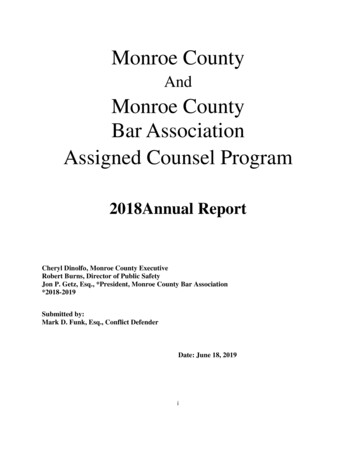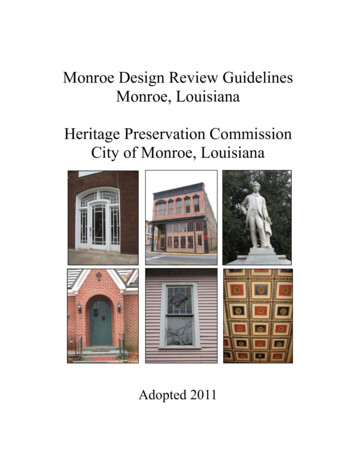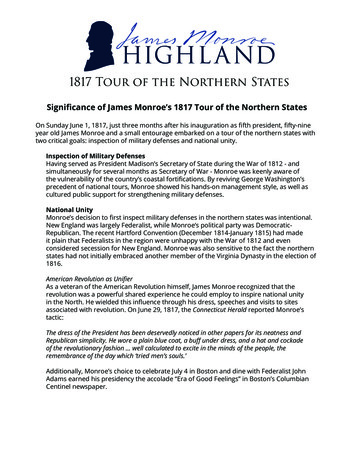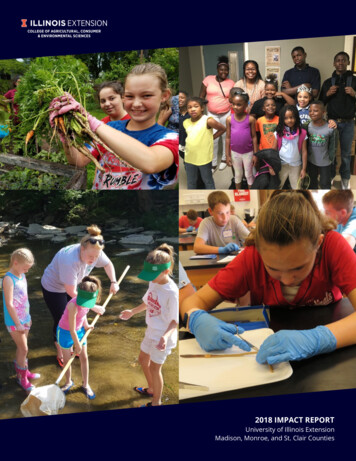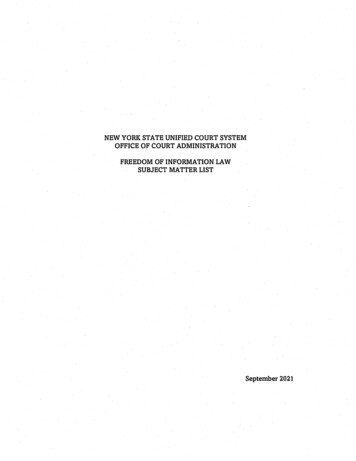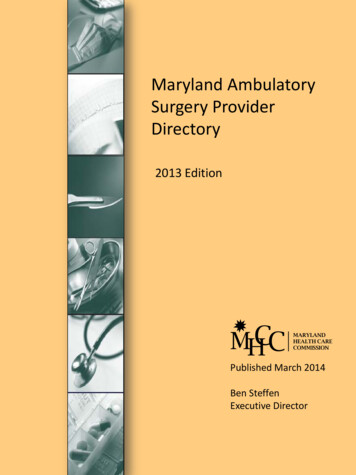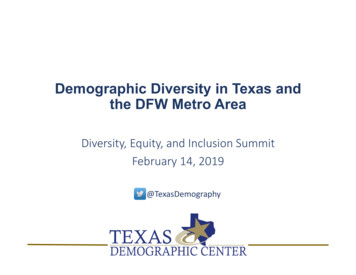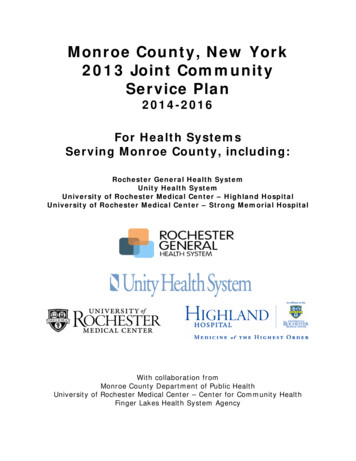
Transcription
Monroe County, New York2013 Joint CommunityService Plan2014-2016For Health SystemsServing Monroe County, including:Rochester General Health SystemUnity Health SystemUniversity of Rochester Medical Center – Highland HospitalUniversity of Rochester Medical Center – Strong Memorial HospitalWith collaboration fromMonroe County Department of Public HealthUniversity of Rochester Medical Center – Center for Community HealthFinger Lakes Health System Agency
Table of ContentsI.Introductionp. 3Mission Statementsp. 4III.Definition of service communityp. 4IV.Public Participationp. 8Selection of public health prioritiesp. 19Three Year Plan of Action 2014-2016a. Priority 1: Worksite Wellnessb. Priority 2: Smoking Cessationc. Priority 3: Chronic Disease Managementp.p.p.p.Dissemination of reportp. 36Maintenance of partner engagementp. 37II.V.VI.VII.VIII.24242831Monroe County Joint Community Service Plan 2014-16 / Page 2
I. IntroductionRochester, NY and its surrounding communities in the Western RochesterRegion have a long history of collaboration to improve the health of theMonroe County residents. Hospital systems in Monroe County includingRochester General Health System, Unity Health System, University ofRochester Medical Center (URMC) Strong Memorial Hospital and HighlandHospital have jointly filed a community service plan to the New York StateDepartment of Health for the past fourteen years, and this year is noexception. This unique effort, done in collaboration with the Monroe CountyDepartment of Public Health (MCDPH) and the Finger Lakes Health SystemAgency (FLHSA), demonstrates true community health assessment andimprovement planning. This partnership assures synergistic, non-duplicativemeaningful strategic efforts towards the common goal of improving thepopulation’s health.This year’s 2013 Monroe County Joint Community Service Plan (JCSP) buildson a collaborative Community Health Needs Assessment and CommunityHealth Improvement Plan that was developed jointly between the hospitalsand the Monroe County Department of Public Health with the assistance ofthe Finger Lakes Health System Agency representing several communityorganizations and initiatives. The Community Health Improvement Plan(CHIP) is based on the NY State Prevention Agenda 2013-2017.Our CHIP and the JCSP are centered on the State Prevention Agenda 2013’sfirst priority area: Preventing Chronic Disease. Collectively and based on ourCommunity Needs Assessment, all hospitals and the MCDPH will concentrateon three focus areas:1. Reduce Obesity in Children and Adults2. Reduce Illness, Disability and Death Related to Tobacco Use andSecondhand Smoke Exposure.3. Increase Access to High-Quality Chronic Disease Preventive Care andManagement in Clinical and Community Settings.Our intervention goals, objectives and action steps will be tackled as acommunity with participation and representation of all hospitals the healthdepartment and FLHSA.The Monroe County hospitals are pleased and proud to submit this JointCommunity Service Plan for 2014-2016.Monroe County Joint Community Service Plan 2014-16 / Page 3
II. Mission StatementsRochester General Health SystemMission Statement: To improve the health of the people served byproviding high quality care, a comprehensive range of services,convenient and timely access, delivered with exceptional service andcompassion.Unity Health SystemVision Statement: Unity will be viewed as the leading provider in themarkets we serve, known for the excellent quality and service that wedeliver to our customers.Mission Statement: The mission of Unity Health System is to make apositive difference in the health and well-being of those we serve.University of Rochester Medical Center – Strong MemorialMission Statement: We improve the well-being of patients andcommunities by delivering innovative, compassionate, patient-familycentered health care, enriched by education, science and technology.University of Rochester Medical Center – Highland HospitalMission Statement: Commitment to excellence in health care, withpatients and their families at the heart of all we do.III. Definition of Community ServedThis plan is a joint submission of the hospitals in Monroe County and hasbeen prepared in collaboration with the Monroe County Department of PublicHealth, and within the context of Monroe County’s Community HealthAssessment. Therefore, the plan’s service area is Monroe County.a. Demographics of the community servedMonroe County is located in western New York, centered on the City ofRochester, with 19 suburban and rural towns. The population of MonroeCounty is 744,344, with 210,565 City residents. Rochester and MonroeCounty serve as the hub for a 5-county metropolitan statistical area with a2010 population of 1,054,323 that share health care and media resources.Monroe County Joint Community Service Plan 2014-16 / Page 4
Within the City of Rochester, certain socioeconomically disadvantagedneighborhoods bear the brunt of health disparities. These areas are referredto as the “Crescent” because they form an arc around the center of the City.The population of the Crescent numbers 143,000.Figure 1: Monroe County, City of Rochester, and the CrescentFourteen percent or 107,488 of Monroe County residents are AfricanAmerican; of those, 78% reside within the City of Rochester. Of theCounty’s 54,055 Latino citizens, 64% reside in the City of Rochester. TheLatino community, mostly of Puerto Rican descent, is the fastest growingsegment of the Rochester population with a 100% increase since 1990.The table below shows the percent of the population by race and Latino origin inMonroe County, the city and suburbs.Table 1: Demographics Monroe CountyPopulation by Race and Latino OriginMonroe County, 2010% White, Not Latino% African American/Black, Not Latino% Latino% Other races, multiple rates, Not LatinoMonroeCounty731476CityTotal3840166Suburbs ofMonroe87545Source: Census 2010Monroe County Joint Community Service Plan 2014-16 / Page 5
Poverty and low educational levels are associated with higher rates of illness,premature death and fair or poor self-reported health status. Having limitedfinancial resources has an impact on access to health care, and the ability topay for medication and purchase healthy food. Literacy levels have aprofound impact on an individual’s ability to manage their health.The median household income in Monroe County is 51,303, slightly belowthe national average ( 51,914). In the city, the median household incomeis 30,540, far below the national average.The table below shows poverty status by residence and race/Latino origin.Table 2: Poverty status in Monroe CountyPoverty StatusMonroeCityCountyTotal% with income below poverty14%30%% White, Not Latino8%19%% African American/Black,32%37%Not Latino% Latino33%42%Source: American Community Survey, 2006-2010Suburbs ofMonroe7%6%14%17%A low graduation rate in the City (Rochester) is a major issue, with only 49%of 9th grade students graduating four years later (source: NYS EducationDepartment, August 2011).One distinct characteristic of Monroe County is the size of the deafpopulation; an estimated 10,000-15,000 primary American Sign Language(ASL) users. The deaf population is heterogeneous and complex,differentiated along lines of educational background, ASL fluency, age ofonset of deafness, as well as race and ethnicity. Racial and ethnic disparitieswithin this group, while likely, have not been well-documented.b. Description of health system and servicesHospitals in Monroe County consists of three “systems” – University ofRochester Medical Center, including Strong memorial Hospital and HighlandHospital and the affiliated FF Thompson Hospital in Ontario County;Rochester General Health System, including Rochester General Hospital andNewark Wayne Community Hospital in Wayne County; and Unity HealthSystem, including Unity Hospital (former Park Ridge Hospital) and theGenesee St campus (formerly St. Mary’s Hospital) All three systems haveassociated nursing homes, health centers or clinics, and hospital-sponsoredmedical practices. Each of the hospitals care for many patients from outsideMonroe County Joint Community Service Plan 2014-16 / Page 6
Monroe County – in the case of Strong Memorial, nearly one-third of patientsare from outside Monroe – making them regional resources.Much of inner city Rochester is federally designated as a Primary Care HealthPersonnel Shortage Areas (HPSA). The map below illustrates the designatedarea in grey. A similar area is also designated as a Dental HPSA.To assist in the provision of quality and accessible medical and health careservices, Monroe long has been served by a network of federally-qualifiedCommunity Health Centers (FQHCs) – Jordan, (sites at Holland Street,Woodward and Brown Square) and Oak Orchard. Rochester Primary CareNetwork (now also an FQHC) has affiliated health centers that also providehealth care within the inner city. These centers include Clinton Family HealthCenter, Genesee Health Center, Northeast Health Services, Orchard StreetCommunity Health Center, and Unity Family Medicine Center.In addition, two free clinics serve primarily individuals who are uninsured –St. Joseph’s Neighborhood Center and the Mercy Outreach Center.Monroe County Joint Community Service Plan 2014-16 / Page 7
IV. Public participation in improvement planningThe development of the Monroe County Community Health NeedsAssessment, Improvement Plan and Joint Community Service plan began in2012 with the organization of the Monroe County Community HealthImprovement Workgroup (formerly the Community Benefits ReportingWorkgroup).The four hospital systems provided financial and in-kind resources for theassessment process, and have supported a chair to convene the Workgroup.The team meets monthly and has been doing so since May 2012. Eachhospital system has one representative spot to the team in addition to publichealth experts from the Monroe County Department of Public Heath(MCDPH), and community member experts from the Finger Lakes HealthSystem Agency (FLHSA). The University of Rochester Center for CommunityHealth serves as a facilitating agency for this process.Table 3: Roster of Team Members (September 2013)NAMETITLEAFFILIATIONAl BradleySenior Project Manager, High BloodPressure InitiativesFinger Lakes Health Systems AgencyWade NorwoodDirector of Community EngagementFinger Lakes Health Systems AgencyExecutive Director & COO –Center for Community HealthDirector of Community Health Policy &Education – Center for Community HealthUniversity of Rochester MedicalCenterUniversity of Rochester MedicalCenterMonroe CountyDepartment of Public HealthMonroe CountyDepartment of Public HealthAndrea DeMeoTheresa Green, MBAAnne KernPublic Health Program CoordinatorByron Kennedy, MD,PhDDirectorBarbara FicarraDirector of Public RelationsHighland HospitalBarbara McManusDirector, Marketing & Public RelationsRochester General Health SystemKathy ParrinelloAssociate VP and COOStrong Memorial HospitalStewart PutnamPresident, Health Care Services DivisionUnity Health SystemWendy WiltsSenior Vice PresidentClinical Service LinesUnity Health Systema. Participants involved in the processThe needs assessment process for Monroe County involved collaborationswith the members of the Community Health Improvement Workgroup(CHIW) as well as several addition community members, organizations andassociations as described below:Monroe County Joint Community Service Plan 2014-16 / Page 8
Rochester General Health SystemRochester General Health System (RGHS) includes eight affiliates anda total team of nearly 10,000 physicians, nurses, team members andvolunteers. The health system has earned national recognition forclinical integration among its affiliates, led by flagship RochesterGeneral Hospital, a 528-bed tertiary care facility that treats moreMonroe County patients than any other hospital. With nearly 124,000emergency patients treated in 2012, the RGH Emergency Departmentis the region’s busiest ED and among the busiest in the state outsideof New York City. RGH is home to the Sands-Constellation HeartInstitute – the state’s fourth largest cardiac center; SCHI is widelyrecognized for leadership in cardiac surgery and overall cardiac care.Other key areas of specialization at Rochester General Hospital includeGeneral, Vascular and Orthopaedic surgery; comprehensive cancercare from the Lipson Cancer Center; and centers of excellence inBreast Cancer treatment, Bariatric Surgery and Minimally InvasiveGynecology.RGHS also includes Newark-Wayne Community Hospital, a 120-bedfacility primarily serving Wayne County; Hill Haven and DeMay LivingCenter, offering post-acute rehabilitation and other long-term careservices to patients of all ages; the Rochester General Medical Group,with more than 40 member practices serving patients throughoutMonroe and Wayne counties; a Behavioral Health Network, providingadult and pediatric care; the Independent Living for Seniors program,enabling elderly patients to live in their own homes with assistancefrom a comprehensive network of supportive medical services; and anAmbulatory Care division that provides outpatient care with widecommunity accessibility. www.rochestergeneral.org.Unity Health SystemUnity Health System has over 70 locations in Rochester and MonroeCounty, including Unity Hospital, located on the Unity Park RidgeHealth Care Campus in the town of Greece, and the Unity St. Mary’sCampus in Rochester.Key services include Orthopaedics; Women’s Services; CardiovascularCare; Primary Care; Diabetes; Behavioral Health; and Neurosciences—including a Spine Center, Stroke Center, and Brain Injury and PhysicalRehabilitation. Unity Medical Group employs over 300 physicians andadvanced practice practitioners. They work alongside a largecomplement of private physicians on the staff at Unity. Unity is alsoMonroe County Joint Community Service Plan 2014-16 / Page 9
engaged in extensive programming designed to meet the needs of theunderserved in Rochester, including a federally-funded Healthy StartCenter and a federally-funded Health Care for the Homeless program.Our Center for Aging has the area’s most comprehensive range ofservices for older adults, which includes specialized care for dementia,a chronic ventilator unit, three skilled nursing facilities, assisted living,a short-stay transitional care center, home health services, adult dayprograms, and The Villages at Unity – an independent senior livingcommunity.ACM Medical Laboratory is a Unity subsidiary and is a world leader ofpatient and clinical trials testing, with locations in western New York;York, England; and India, as well as laboratory partnerships across theglobe.University of Rochester Medical CenterOne of the nation’s top academic medical centers, URMC forms thecenterpiece of a patient care network consists of Strong Memorial Hospital(including Golisano Children’s Hospital), Highland Hospital and affiliates,Thompson Health, the Eastman Institute for Oral Health, Visiting NurseService, and the University of Rochester Medical Faculty Group. Studentrosters include approximately 400 medical students, 550 graduate students,and 600 residents and fellows who are engaged in community servicethroughout their education.Strong Memorial HospitalThe University’s health care delivery network is anchored by StrongMemorial Hospital, an 800-bed, University-owned teachinghospital. Strong boasts a state-designated Level One Trauma and BurnCenter, pioneering transplant programs, a comprehensive cardiacservice, esteemed programs for conditions such as Parkinson’sDisease, epilepsy, and other neuromuscular illnesses, as well astertiary care pediatric services delivered through the 132-bed GolisanoChildren’s Hospital. With a solid reputation for quality, Strong Memorialhas earned the National Research Corporation’s “Consumer ChoiceAward” all 17 years since the award’s inception.U.S. News & World Report consistently lists Strong’s adult andpediatric specialty programs in its rankings of Best Hospitals inAmerica. Last year, Strong ranked two adult specialties in the Top 50 –Neurology/Neurosurgery and Urology – in addition to nine “highperforming” specialties, with scores nearly as high as the Top 50. Inaddition, four pediatric specialties – Orthopaedics, Neonatology,Monroe County Joint Community Service Plan 2014-16 / Page 10
Gastroenterology, and Neurology/Neurosurgery – rank in the Top 50.Additionally, the Joint Commission has recognized Strong’s leadingpatient care. The Palliative Care Program received the Gold Seal ofApproval from the Commission, becoming the third in the nation – andthe first at an academic medical center – to receive this level ofrecognition. The Commission also awarded special recognition to theProgram in Heart Failure and Transplantation for both its heart failureand ventricular assist device programs. Strong offers the onlycomprehensive cardiac program in Upstate New York, with preventionservices, cutting-edge treatments and devices, surgical options, andUpstate New York’s only cardiac transplant service. Recently the centerwas the first in upstate to implant a total artificial heart.Strong’s cardiac and stroke programs are consistently honoredannually by the American Heart Association/American StrokeAssociation’s Get With the Guidelines initiative. Recent recognitionincludes the GWTG highest honor, the Stroke Gold Plus QualityAchievement Award for care provided by its state-designated strokecenter, a Gold Achievement Award for heart failure, and a SilverAchievement Award for resuscitation. Strong also was tapped for theTarget: Stroke Honor Role, which recognizes hospitals that haveconsistently and successfully reduced the time between a strokevictim’s arrival at the hospital and treatment.Highland HospitalHighland is an affiliate of the University of Rochester Medical Center. Itincludes the 261-bed acute care hospital located at 1000 SouthAvenue in Rochester, Highland Family Medicine practice and 14Primary Care-affiliated practices. The hospital has 2,519 employees;715 are nursing staff members and 226 are mid-level providers, Themedical staff, which includes employee physicians and those who docases or refer patients to the hospital, numbers 1253.The hospital serves the urban Rochester area and surroundingcounties (Monroe, Genesee, Livingston, Ontario, Orleans and Wayne).Patients also travel to Highland from the Upstate New York region andPennsylvania for its specialty services, which include:Orthopaedics/Joint Replacement; Bariatric Surgery; Geriatrics;Women’s Services.Highland Hospital conducts many health and wellness education eventsthroughout the year. Examples include free or low-cost healtheducation programs on topics related to geriatric health, diabetesmanagement, joint pain/joint replacement, and bariatric surgery.Monroe County Joint Community Service Plan 2014-16 / Page 11
Highland’s Breast Imaging Center partners with the Breast CancerCoalition of Rochester and the Monroe County Cancer Servicesprogram to sponsor free mammography screening days several timesa year for uninsured/underinsured women. These events serveseveral purposes: they raise awareness of the breadth of servicesoffered by Highland to the community, especially those in the urbanarea of Rochester for whom Highland is their closest hospital; theyencourage community members to engage in proactive wellnessefforts, such as recommended annual mammograms for women over40 and those at risk; and they educate community members on stepsthey can take to lead healthy lives through positive lifestyle choices.Highland staff provide health information and wellness screenings atnumerous community events such as annual health fairs.In addition to the outstanding health care system in Monroe County, severalother resources are available through collaborative organizations, mostnotably:The Monroe County Department of Public Health (MCDPH) providesdirect services designed to protect the public from health risks, disease andenvironmental hazards by providing preventive services education andenforcement of health codes. The Division of Disease Control and Preventionprovides essential health care services to the residents of Monroe County inthe areas of disease surveillance, clinical services and preventive healtheducation in order to prevent and control the spread of communicabledisease, provide preventive care, treatment and medical case managementto children in the care of Monroe County’s Foster Care system. The Divisionof Maternal Child Health provides public health services to children andfamilies in order to ensure healthy births and improve health anddevelopmental outcomes for all children. Services include home visiting andoutreach through nurses (Nurse Family Partnership) and community healthworkers to high risk pregnant women and their families, and visits by EarlyIntervention (EI) staff to families and children with suspected developmentaldelays. The Environmental Health Division promotes the improved healthstatus of the community including individuals, business and industry,institutions and government by providing information and education;inspection of facilities or conditions that affect public health and theenvironment; enforcement of provisions of the Public Health Law,Environmental Conservation Law, the New York State Sanitary Code and theMonroe County Sanitary Code; emergency response to incidents thatthreaten public health and the environment; and coordination of programplanning for county activities that protects public health and theenvironment.Monroe County Joint Community Service Plan 2014-16 / Page 12
In addition to providing these services, the Department leads a communityhealth improvement effort called HEALTH ACTION. The HEALTH ACTIONprocess involves assessing the health status of residents, communityparticipation in priority setting and collaboration to assess common goals.The University of Rochester Medical Center (URMC) has a long-standingand unusually robust commitment to community health, recognized as itsfourth mission, along with research, education and patient care. The Centerfor Community Health (CCH) was established in 2006 to support communityacademic public health partnerships and to provide consultation to faculty,students and staff to establish community initiatives and research. Itsmission is to join forces with the community to eliminate disparities andimprove health through research, education and service. Today, the CCHincludes more than 60 faculty and staff and manages multiple programsfunded by 5.6 million per year (Calendar year 2011) of extramural funding.In addition, the CCH is supported by the URMC financial, legal, andmanagement infrastructure.The Finger Lakes Health Systems Agency (FLHSA) is the communitybased health planning agency dedicated to promoting the health of theregion’s population. The organization provides a neutral community table forcomprehensive planning among the health systems of the region. Inaddition, FLHSA is skilled in supporting and facilitating diverse coalitions.They have provided coordination and staff-support to the African Americanand Latino Health Coalitions and are the lead agency for HEALTHI Kids andfor the Rochester Business Alliance High Blood Pressure Initiative. HEALTHI Kids is a policy and practice advocacy coalition addressingenvironmental solutions to promote healthy weight among children.The HEALTHI Kids’ Policy Team includes 27 organizations. Funded bythe Greater Rochester Health Foundation (GRHF), the Robert WoodJohnson Foundation under its Healthy Kids, Healthy Communitiesinitiative, and the NY Department of Health, this coalition hasgalvanized over 1,000 community constituents. The African American and Latino Health Coalitions, convened under theFLHSA umbrella, bring together community members, healthprofessionals, and the FLHSA staff to define unmet needs, engagecommunity members, develop new thought leaders, increasecommunity knowledge, and develop standards and improve collectionof data on patients’ race, ethnicity, and preferred language. Eachcoalition has created a comprehensive report identifying pressinghealth issues and disparities confronting their respective communities.The Nuestra Salud ("Our Health") report offers strategies to expandaccess to care, reduce the uninsured Latino population, help healthMonroe County Joint Community Service Plan 2014-16 / Page 13
care providers meet the unique needs of Latinos, and empower theLatino community to be better health care consumers. The “What’sGoin on?” report specifically explores the link between the culturalenvironment and health behaviors for African Americans and makes acollective call for community action.The business community, through the Rochester Business Alliance’s(RBA) Health Planning Group and the Worksite Health Alliance of GreaterRochester, are increasingly engaged in addressing health in the worksite andthe community. The RBA has worked with the community on a variety ofhealth issues including support for the local regional health care informationorganization, the application of Lean Six Sigma approaches to hospitalmanagement, and physician compensation. The “eat well, live well”challenge, sponsored by Wegmans Food Markets (Business Week 11/23/09;HHS Certificate of Recognition for Outstanding Prevention Efforts, 2007) hasbeen effective in promoting physical activity and nutrition. Over the pastfour years, 160,000 employees of 350 local organizations have participated,walking more than 60 billion steps and consuming 24 million cups of fruitsand vegetables.Most recently, the RBA and the Finger Lakes Health Systems Agency havedeveloped the High Blood Pressure Collaborative, a group of more than 70individuals from 40 organizations, working together to increase thepercentage of people with high blood pressure who meet goal blood pressuremeasures through interventions in worksites, the community and the healthcare system. The long term goal is to decrease the incidence of heartattacks, heart failure, strokes, and kidney failure.The Smoking and Health Action Coalition (SHAC) of Monroe County is aCommunity Partnership of the New York State Tobacco Control Program. Thegoals of the coalition are to: promote cessation from tobacco use; decreasethe social acceptability of tobacco use; prevent the initiation of tobacco useamong youth and young adults; eliminate exposure to secondhand smoke.Current coalition projects include educating leaders and communitymembers about smoke-free parks and playgrounds, and working withtenants and landlords on implementing smoke-free multi-unit housing.Current member agencies include: MCDPH, American Lung Association,American Heart Association, American Cancer Society, the Monroe CountyMedical Society, and the Smoking Research Program at the URMC.Another community asset is the Deaf Health Community Coalition(DHCC) which oversees the National Center for Deaf Health Research(NCDHR), a CDC-funded prevention research center. Initially funded in2004, NCDHR’s mission is health promotion and disease prevention withMonroe County Joint Community Service Plan 2014-16 / Page 14
deaf and hard-of-hearing populations through community basedparticipatory research.Two recent Rochester community health grant awards are notable:Transforming Primary Care Delivery: Monroe County CMMI GrantIn July 2012, the Finger Lakes Health System Agency was awarded 26.6Mthrough the Centers for Medicaid and Medicare Innovations (CMMI) to beused for the project: Transforming Primary Care Delivery: A CommunityPartnership. Over the three year grant period, Finger Lakes and thecommunity will work with 65 primary care practices, integrating thesepractices with those already involved with the on-going Primary Care MedicalHome pilot and care manager project practices. This penetration will reach80% of the at-risk population by year three in the six county region. Theintervention will target practices with high numbers of patients “at risk” foravoidable utilization of hospital and ED services.This was the largest CMMI grant awarded nationwide and is understandablya huge resource and transforming force for the community in MonroeCounty. All hospital systems are involved in this grant and most of the 65targeted primary care practices are affiliated with one of the hospitalsystems.HEART: Monroe County Community Transformation GrantIn 2011 the University of Rochester Medical Center, the Monroe CountyDepartment of Public Health and numerous community partners wereawarded a five-year, 3.6 million Community Transformation Grant (CTG) bythe Centers for Disease Control and Prevention. The funding will be used todevelop HEART (Health Engagement and Action for Rochester’sTransformation), a comprehensive initiative to improve the health of MonroeCounty residents by creating a community environment that supportshealthy behaviors, thus preventing chronic disease and reducing health carecosts.Community Transformation Grants were awarded to communities in the U.S.to create healthier communities by making healthy living easier and moreaffordable where people work, live, learn, and play. The core principles ofCTG’s are to maximize health through prevention, advance health equity andreduce health disparities.Monroe County Joint Community Service Plan 2014-16 / Page 15
b. Community inputHEALTH ACTION is a community health improvement initiative that uses dataand community input to select priority health goals, and develops interventionsto address these goals. The four health systems represented in our communityservice plan are key participants in this process along with several othercommunity agencies of diverse disciplines.Health assessments by lifecycle groups, in the form of report cards, aredeveloped by the Monroe County Department of Public Health under thedirection of report card advisory committe
Genesee St campus (formerly St. Mary's Hospital) All three systems have associated nursing homes, health centers or clinics, and hospital-sponsored . Executive Director & COO - Center for Community Health University of Rochester Medical Center . Theresa Green, MBA . Director of Community Health Policy & Education - Center for Community .
